Dynamic Characteristics and Flow Field Evolution of Flat Plate Water Entry Slamming Based on Smoothed Particle Hydrodynamics
Abstract
:1. Introduction
2. Numerical Methods
2.1. SPH Formulation
2.2. Boundary Conditions
3. Results and Discussion
3.1. Model Validations
3.1.1. Numerical Models
3.1.2. Effect of Particle Resolution
3.1.3. Validations of Numerical Results
3.2. Slamming Dynamics
3.2.1. Pressure Distribution
3.2.2. Analysis of Response Extreme Value
3.2.3. Analysis of the Slamming Coefficient
3.3. Water Surface Evolution during Water Entry
3.3.1. Water Surface Evolution
3.3.2. Analysis of Evolutionary Parameters
4. Conclusions
- (1)
- SPH effectively captures the key dynamic characteristics of a flat plate entering water. In the numerical model established in this paper, SPH particles effectively simulate jet formation, cavity development, and fluid splash behavior during the water entry of the flat plate, clearly reproducing the phenomena of jet tip separation and droplet breakup. The maximum pressures and maximum vertical forces of the flat plate at two water entry velocities agree well with the experimental data, with an error margin of 5%.
- (2)
- The pressure of the flat plate surface is highest at the center and gradually decreases towards the edges, with the lowest pressure at the edges, especially at the four corners of the flat plate. The maximum pressure and vertical force of the plate have a second-order nonlinear relationship with the water entry velocity. However, the dimensionless maximum pressure coefficient and vertical force coefficient do not change with the water entry velocity; their values remain consistent across different velocities.
- (3)
- The flow evolution of the flat plate entering the water exhibits distinct stages. Stage I involves the initial formation of the jet and cavity when the flat plate impacts the water surface. Stage II sees further development of the cavity and jet, accompanied by jet tip separation. Stage III involves the continued development of jet tip separation, leading to fragmentation of the jet tip and the gradual formation of splashing droplets. Stage IV continues the development of jet tip separation and droplet fragmentation while the cavity begins to contract inward.
- (4)
- The cavity width and splash height during the water entry slamming of the flat plate grow nonlinearly with the entry depth of the plate in the water. The growth rates of the cavity width and splash height gradually diminish as depth increases. The water entry velocity has the greatest influence on droplet splashing, with the horizontal cavity width from the center at the maximum splashing droplet height and the vertical height from the free liquid surface showing pronounced nonlinear growth with water entry velocity. However, the water entry velocity has a minor influence on the positions of the jet separation point and the free liquid surface. The cavity width from the center at the jet separation point is essentially consistent with the vertical distance of the flat plate from the free liquid surface at its position in the water.
Author Contributions
Funding
Institutional Review Board Statement
Informed Consent Statement
Data Availability Statement
Conflicts of Interest
References
- Bilandi, R.N.; Mancini, S.; Vitiello, L.; Miranda, S.; De Carlini, M. A Validation of Symmetric 2D + T Model Based on Single-Stepped Planing Hull Towing Tank Tests. J. Mar. Sci. Eng. 2018, 6, 136. [Google Scholar] [CrossRef]
- Chillemi, M.; Raffaele, M.; Sfravara, F. A Review of Advanced Air Lubrication Strategies for Resistance Reduction in the Naval Sector. Appl. Sci. 2024, 14, 5888. [Google Scholar] [CrossRef]
- Fairlie-Clarke, A.C.; Tveitnes, T. Momentum and gravity effects during the constant velocity water entry of wedge-shaped sections. Ocean Eng. 2008, 35, 706–716. [Google Scholar] [CrossRef]
- Zhang, X.; Shi, Y.; Pan, G. Modified analytical model for water entry of two-dimensional elastic cylinders based on continuum theory. Ocean Eng. 2021, 240, 110010. [Google Scholar] [CrossRef]
- Tavakoli, S.; Mikkola, T.; Hirdaris, S. A fluid–solid momentum exchange method for the prediction of hydroelastic responses of flexible water entry problems. J. Fluid Mech. 2023, 965, A19. [Google Scholar] [CrossRef]
- Vincent, L.; Xiao, T.; Yohann, D.; Jung, S.; Kanso, E. Dynamics of water entry. J. Fluid Mech. 2018, 846, 508–535. [Google Scholar] [CrossRef]
- Shi, Y.; Xiao, P.; Zhao, H.; Pan, G. Experimental Research on the Influences of Head Shape and Surface Properties on the Water Entry Cavity. J. Mar. Sci. Eng. 2022, 10, 1411. [Google Scholar] [CrossRef]
- Liu, H.; Zhou, B.; Yu, J.; Liu, K.; Han, X.; Zhang, G. Experimental investigation on the multiphase flow characteristics of oblique water entry of the hollow cylinders. Ocean Eng. 2023, 272, 113902. [Google Scholar] [CrossRef]
- Wang, Y.; Wang, F.; Yin, J.; Wei, Y.; Wang, C. Experimental study on synchronous high-speed vertical water entry of cylinders. Phys. Fluids 2024, 36, 057115. [Google Scholar] [CrossRef]
- Speirs, N.B.; Mansoor, M.M.; Belden, J.; Truscott, T.T. Water entry of spheres with various contact angles. J. Fluid Mech. 2019, 862, R3. [Google Scholar] [CrossRef]
- Yi, L.; Li, S.; Jiang, H.; Lohse, D.; Sun, C.; Mathai, V. Water entry of spheres into a rotating liquid. J. Fluid Mech. 2021, 912, 1–10. [Google Scholar] [CrossRef]
- Huera-Huarte, F.; Jeon, D.; Gharib, M. Experimental investigation of water slamming loads on panels. Ocean Eng. 2011, 38, 1347–1355. [Google Scholar] [CrossRef]
- Ma, Z.H.; Causon, D.M.; Qian, L.; Mingham, C.G.; Mai, T.; Greaves, D.; Raby, A. Pure and aerated water entry of a flat plate. Phys. Fluids 2016, 28, 016104. [Google Scholar] [CrossRef]
- Talioua, A.; Berkane, B.; Martin, M.B.; Perret, G.; Pinon, G. Flat plate pressure impact on a still water surface: The effect of surrounding ambient pressure and plate size. Ocean Eng. 2022, 263, 111926. [Google Scholar] [CrossRef]
- Chen, Z.; Jiao, J.; Wang, S.; Guedes Soares, C. CFD-FEM simulation of water entry of a wedged grillage structure into Stokes waves. Ocean Eng. 2023, 275, 114159. [Google Scholar] [CrossRef]
- Kleefsman, K.M.T.; Fekken, G.; Veldman, A.E.P.; Iwanowski, B.; Buchner, B. A Volume-of-Fluid based simulation method for wave impact problems. J. Comput. Phys. 2005, 206, 363–393. [Google Scholar] [CrossRef]
- Yuan, H.-T.; Sun, J.-Y.; Sun, S.-L.; Zhang, Z.-F.; Ren, H.-L. Vertical water entry of a cylinder considering wind and linearly sheared flow effect: A numerical investigation. Phys. Fluids 2024, 36, 032114. [Google Scholar] [CrossRef]
- Wu, X.; Wu, L.; Yu, P.; Chang, X. Investigation of the Impact Load Characteristics during Water Entry of Airdropped Underwater Gliders. J. Mar. Sci. Eng. 2024, 12, 808. [Google Scholar] [CrossRef]
- Qi, C.; Lyu, X.; Wang, X.; Ye, H.; Shi, H.; Wan, Z. Experimental and numerical studies on vertical water entry of a cylinder under the influence of current. Phys. Fluids 2024, 36, 033322. [Google Scholar] [CrossRef]
- Xiao, Y.; Zhang, G.; Hui, D.; Yan, H.; Feng, S.; Wang, S. Numerical simulation for water entry and exit of rigid bodies based on the immersed boundary-lattice Boltzmann method. J. Fluids Struct. 2022, 109, 103486. [Google Scholar] [CrossRef]
- Zhang, F.; Zhang, L.; Xie, Y.; Wang, Z.; Shang, S. Smoothed Particle Hydrodynamics Simulation of a Mariculture Platform under Waves. Water 2021, 13, 2847. [Google Scholar] [CrossRef]
- Chen, J.; Bai, X.; Wang, J.; Chen, G.; Zhang, T. Research on Sea Spray Distribution of Marine Vessels Based on SPH-FEM Coupling Numerical Simulation Method. Water 2022, 14, 3834. [Google Scholar] [CrossRef]
- Cai, X.; Wu, W.; Han, W.; Li, W.; Zhang, J.; Jiao, Y. Study on Water Entry of a 3D Torpedo Based on the Improved Smoothed Particle Hydrodynamics Method. Appl. Sci. 2024, 14, 4441. [Google Scholar] [CrossRef]
- Hammani, I.; Marrone, S.; Colagrossi, A.; Oger, G.; Le Touzé, D. Detailed study on the extension of the δ-SPH model to multi-phase flow. Comput. Methods Appl. Mech. Eng. Technol. 2020, 368, 113189. [Google Scholar] [CrossRef]
- Zhao, Z.-X.; Hong, Y.; Gong, Z.-X.; Liu, H. Numerical analysis of cavity deformation of oblique water entry using a multi-resolution two-phase SPH method. Ocean Eng. 2023, 269, 113456. [Google Scholar] [CrossRef]
- Zhao, Z.-X.; Bilotta, G.; Yuan, Q.-E.; Gong, Z.-X.; Liu, H. Multi-GPU multi-resolution SPH framework towards massive hydrodynamics simulations and its applications in high-speed water entry. J. Comput. Phys. 2023, 490, 112339. [Google Scholar] [CrossRef]
- Chen, C.; Zhang, A.-M.; Chen, J.-Q.; Shen, Y.-M. SPH simulations of water entry problems using an improved boundary treatment. Ocean Eng. 2021, 238, 109679. [Google Scholar] [CrossRef]
- Zhang, H.; Zhang, Z.; He, F.; Liu, M. Numerical investigation on the water entry of a 3D circular cylinder based on a GPU-accelerated SPH method. Eur. J. Mech. B Fluids 2022, 94, 1–16. [Google Scholar] [CrossRef]
- Lyu, H.-G.; Sun, P.-N.; Miao, J.-M.; Zhang, A.-M. 3D multi-resolution SPH modeling of the water entry dynamics of free-fall lifeboats. Ocean Eng. 2022, 257, 111648. [Google Scholar] [CrossRef]
- Fang, X.-L.; Ming, F.-R.; Wang, P.-P.; Meng, Z.-F.; Zhang, A.-M. Application of multiphase Riemann-SPH in analysis of air-cushion effect and slamming load in water entry. Ocean Eng. 2022, 248, 110789. [Google Scholar] [CrossRef]
- Zhao, K.; Yang, S.-F.; Ming, F.-R. Numerical analysis of water entry under ocean currents with smoothed particle hydrodynamics method. Phys. Fluids 2023, 35, 062103. [Google Scholar]
- Wang, S.; González-Cao, J.; Islam, H.; Gómez-Gesteira, M.; Guedes Soares, C. Uncertainty estimation of mesh-free and mesh-based simulations of the dynamics of floaters. Ocean Eng. 2022, 256, 111386. [Google Scholar] [CrossRef]
- Domínguez, J.M.; Fourtakas, G.; Altomare, C.; Canelas, R.B.; Tafuni, A.; García-Feal, O.; Martínez-Estévez, I.; Mokos, A.; Vacondio, R.; Crespo, A.J. DualSPHysics: From fluid dynamics to multiphysics problems. Comput. Part. Mech. 2022, 9, 867–895. [Google Scholar] [CrossRef]
- Wendland, H. Piecewise polynomial, positive definite and compactly supported radial functions of minimal degree. Adv. Comput. Math. 1995, 4, 389–396. [Google Scholar] [CrossRef]
- Monaghan, J.J. Smoothed particle hydrodynamics. Annu. Rev. Astron. Astrophys. 1992, 30, 543–574. [Google Scholar] [CrossRef]
- Monaghan, J.J.; Gingold, R.A. Shock simulation by the particle method SPH. J. Comput. Phys. 1983, 52, 374–389. [Google Scholar] [CrossRef]
- Monaghan, J.J.; Kos, A. Solitary waves on a Cretan beach. J. Waterw. Port Coast. Ocean. Eng. 1999, 125, 145–155. [Google Scholar] [CrossRef]
- Batchelor, G.K. An Introduction to Fluid Dynamics; Cambridge University Press: Cambridge, UK, 2000. [Google Scholar]
- Marrone, S.; Colagrossi, A.; Chiron, L.; De Leffe, M.; Le Touzé, D. High-speed water impacts of flat plates in different ditching configuration through a Riemann-ALE SPH model. J. Hydrodyn. 2018, 30, 38–48. [Google Scholar] [CrossRef]
- Leimkuhler, B.; Matthews, C. Molecular Dynamics: With Deterministic and Stochastic Numerical Methods; Springer International Publishing: Berlin/Heidelberg, Germany, 2015. [Google Scholar]
- Crespo, A.J.C. DualSPHysics. Available online: https://github.com/DualSPHysics/DualSPHysics/wiki (accessed on 12 July 2024).
- Mai, T.; Mai, C.; Raby, A.; Greaves, D.M. Aeration effects on water-structure impacts: Part 1. drop plate impacts. Ocean Eng. 2019, 193, 106600. [Google Scholar] [CrossRef]
- O’Connor, C.; Mohajernasab, S.; Abdussamie, N. Numerical investigation into water entry problems of a flat plate with air pockets. J. Ocean. Eng. Sci. 2023, 8, 386–400. [Google Scholar] [CrossRef]

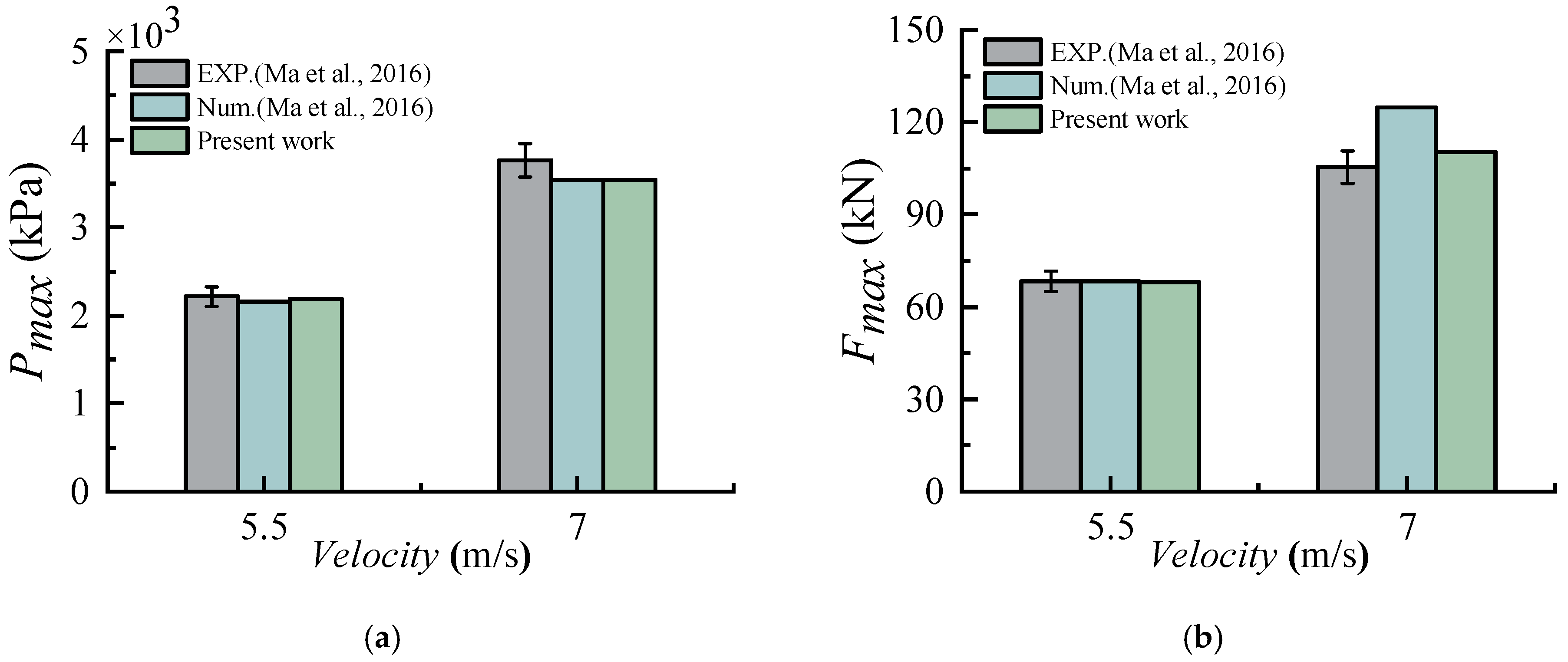
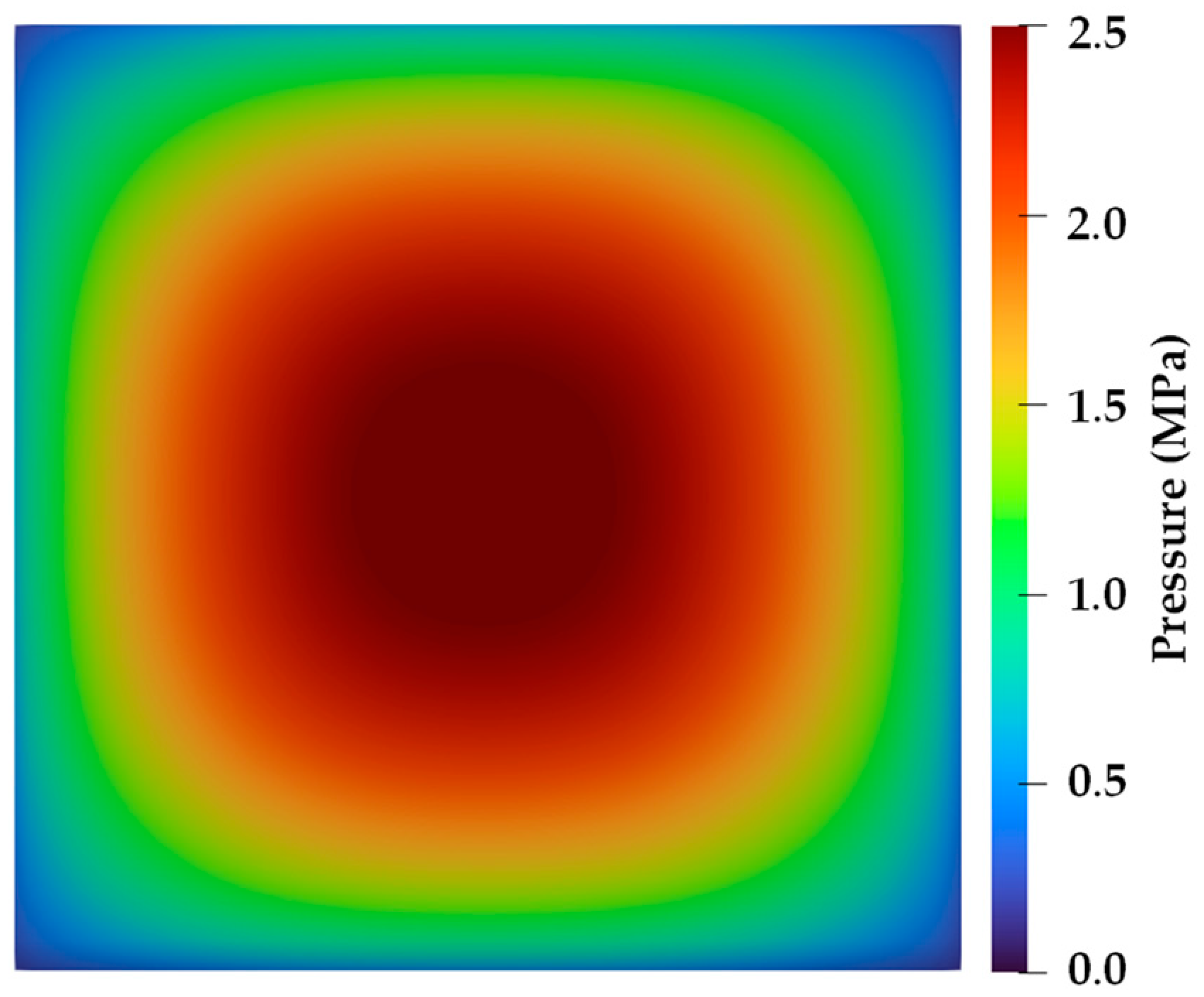


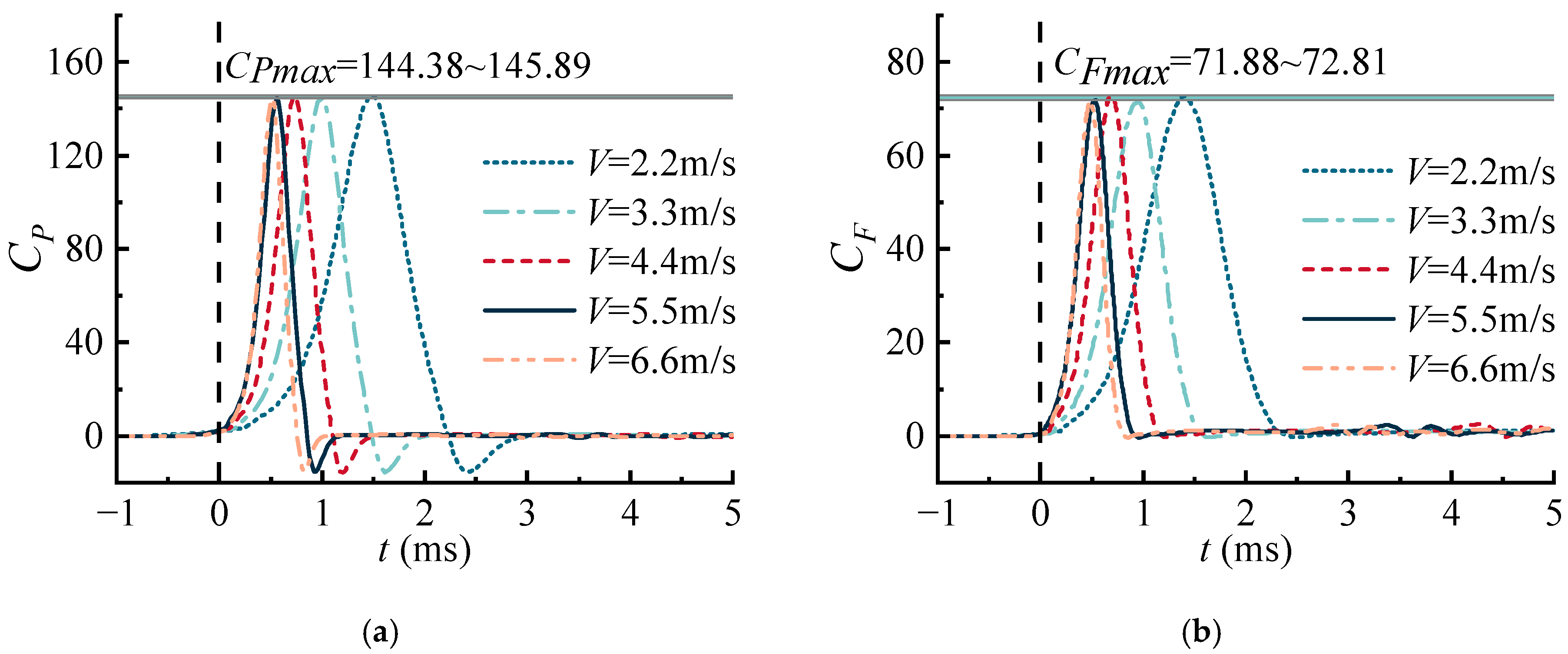
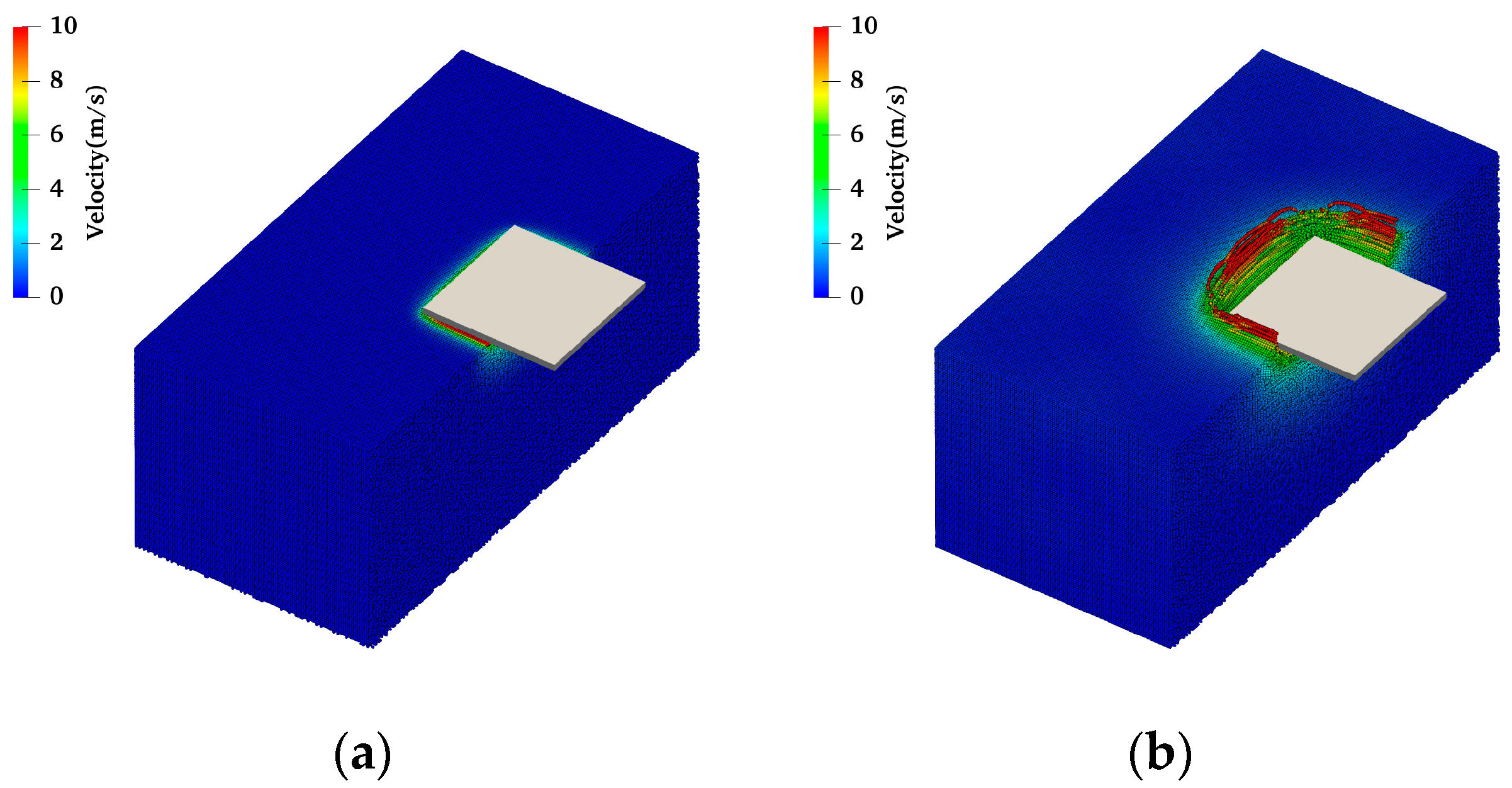


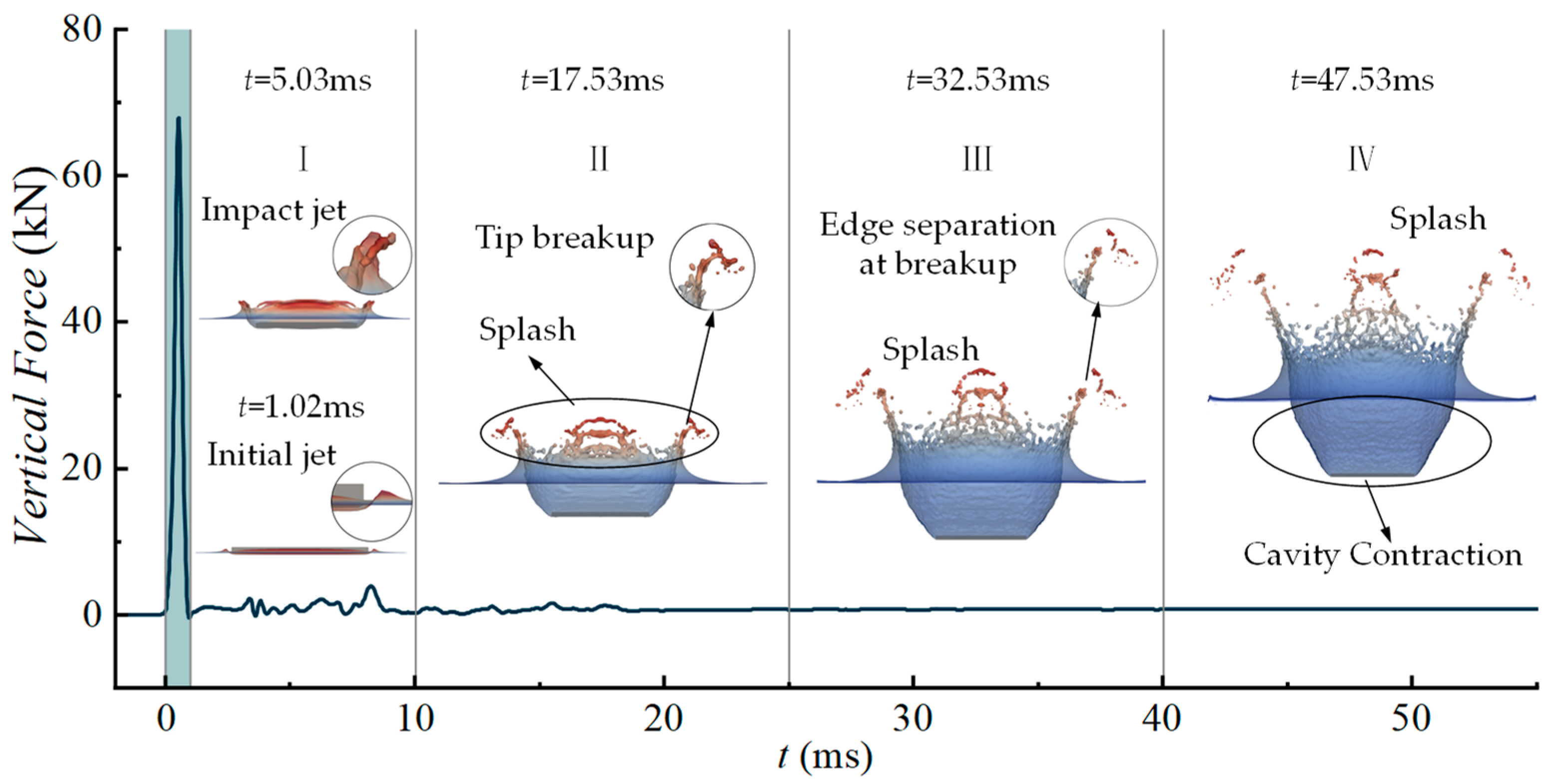
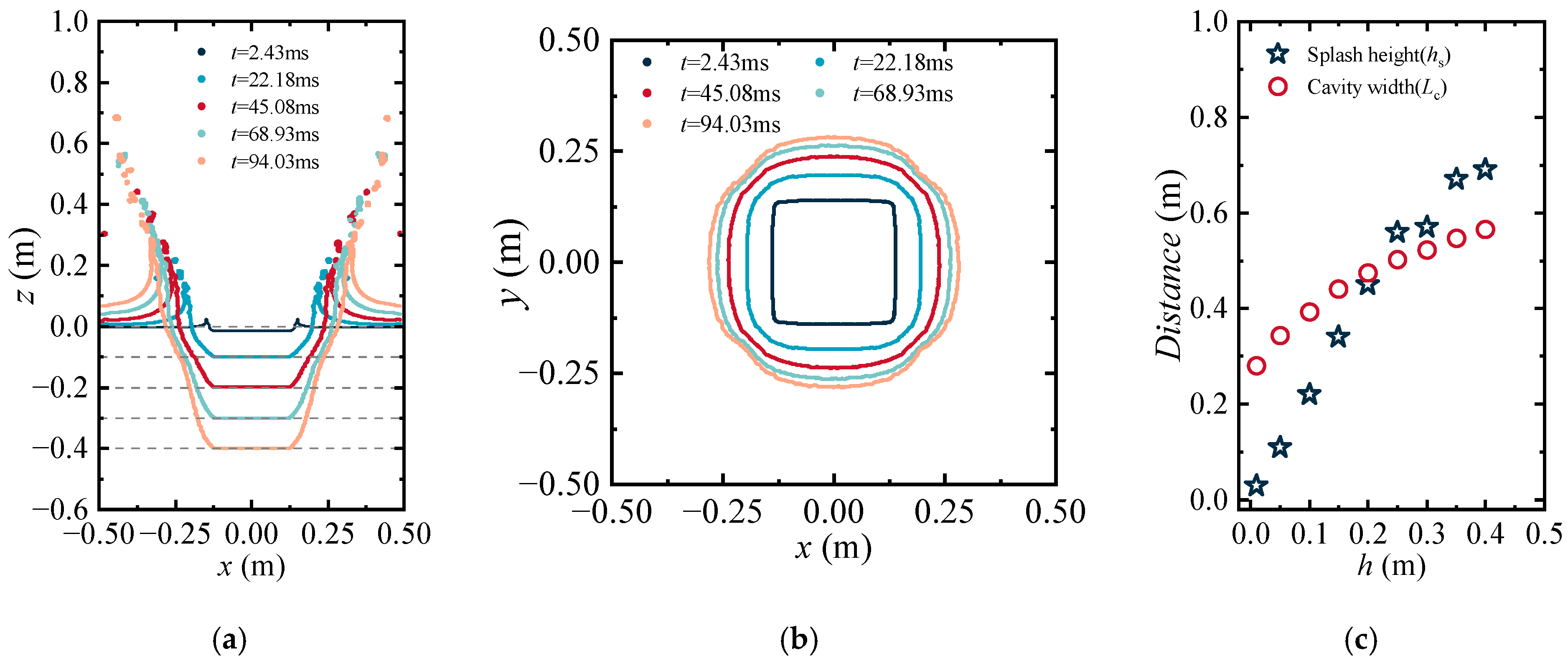
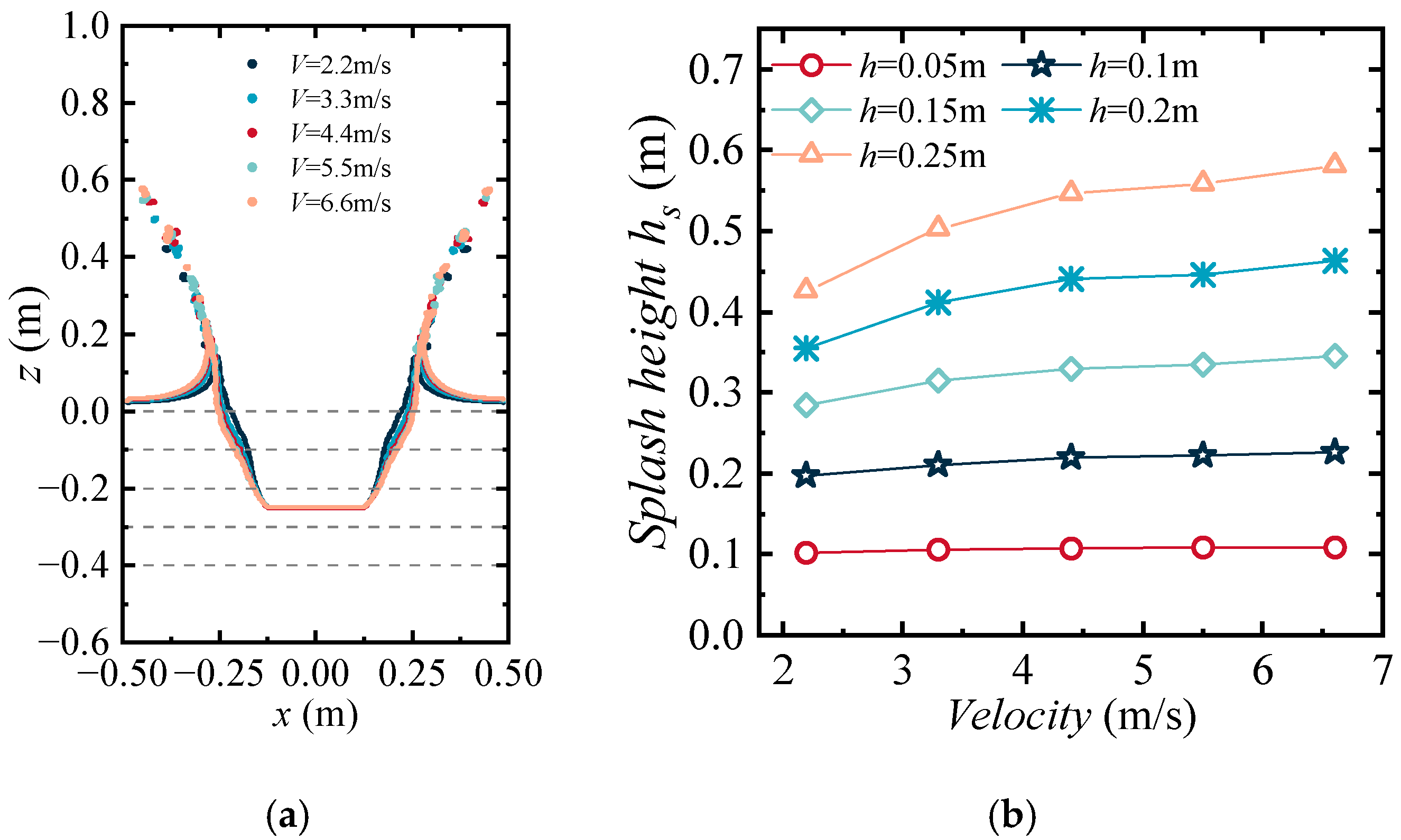
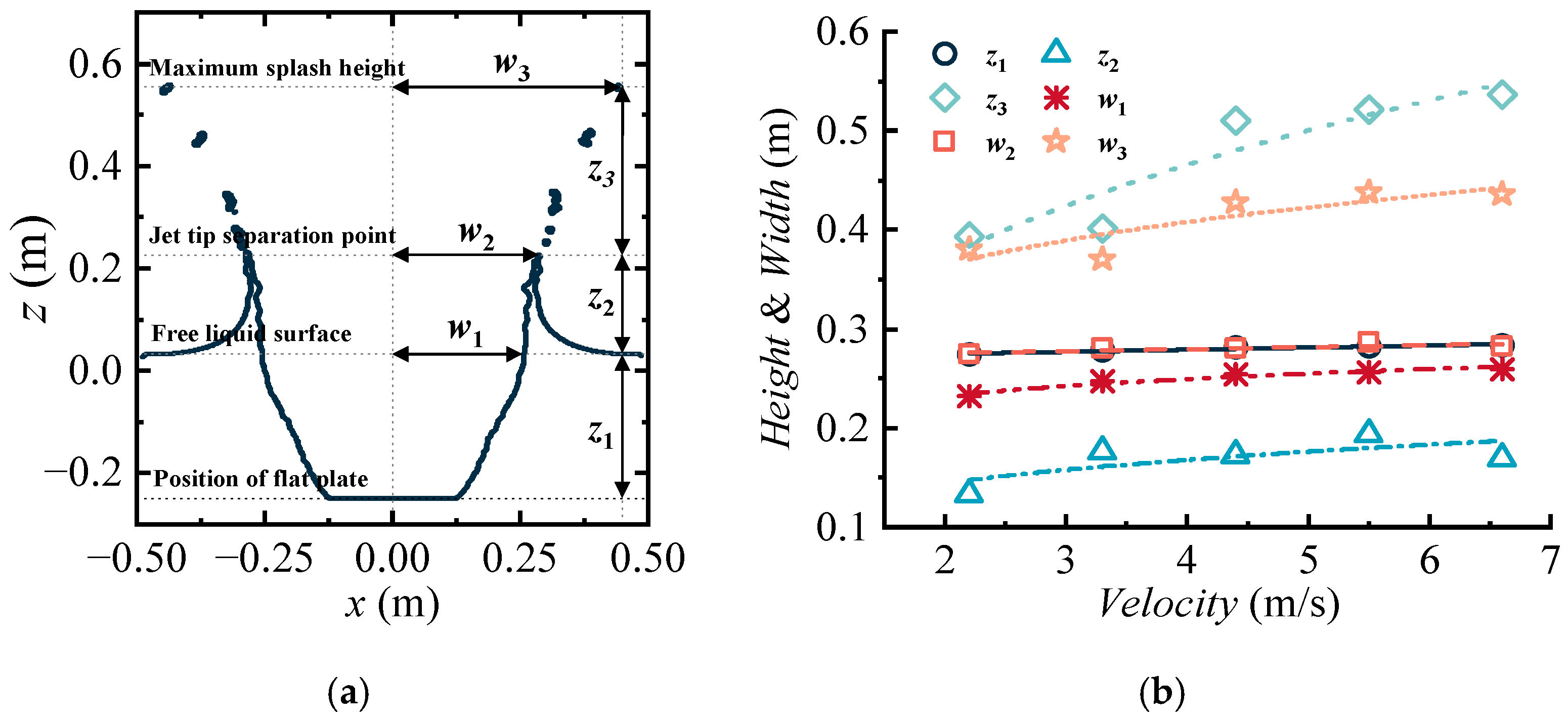
| SPH Parameters | Value |
|---|---|
| Fluid particle density (kg/m3) | 1000 |
| Initial spacing of fluid particles (m) | 0.004 |
| Total number of SPH particles | 8,312,418 |
| Smooth kernel functions | Wendland |
| Smooth length (m) | 0.0056 |
| Artificial viscosity coefficient | 0.01 |
| Sound velocity coefficient | 60 |
| dp (m) | Pmax (kPa) | Relative Error (%) | Fmax (kN) | Relative Error (%) |
|---|---|---|---|---|
| 0.0050 | 1818.75 | −8.05 | 55.25 | −14.09 |
| 0.0046 | 1977.88 | −9.48 | 64.31 | −5.36 |
| 0.0040 | 2185.01 | 0.56 | 67.95 | −3.97 |
| 0.0036 | 2172.87 | - | 70.76 | - |
Disclaimer/Publisher’s Note: The statements, opinions and data contained in all publications are solely those of the individual author(s) and contributor(s) and not of MDPI and/or the editor(s). MDPI and/or the editor(s) disclaim responsibility for any injury to people or property resulting from any ideas, methods, instructions or products referred to in the content. |
© 2024 by the authors. Licensee MDPI, Basel, Switzerland. This article is an open access article distributed under the terms and conditions of the Creative Commons Attribution (CC BY) license (https://creativecommons.org/licenses/by/4.0/).
Share and Cite
Li, Z.; Zan, Y.; Guo, R.; Sun, Y.; Sun, N. Dynamic Characteristics and Flow Field Evolution of Flat Plate Water Entry Slamming Based on Smoothed Particle Hydrodynamics. J. Mar. Sci. Eng. 2024, 12, 1491. https://doi.org/10.3390/jmse12091491
Li Z, Zan Y, Guo R, Sun Y, Sun N. Dynamic Characteristics and Flow Field Evolution of Flat Plate Water Entry Slamming Based on Smoothed Particle Hydrodynamics. Journal of Marine Science and Engineering. 2024; 12(9):1491. https://doi.org/10.3390/jmse12091491
Chicago/Turabian StyleLi, Zhongming, Yingfei Zan, Ruinan Guo, Yaogang Sun, and Nan Sun. 2024. "Dynamic Characteristics and Flow Field Evolution of Flat Plate Water Entry Slamming Based on Smoothed Particle Hydrodynamics" Journal of Marine Science and Engineering 12, no. 9: 1491. https://doi.org/10.3390/jmse12091491






